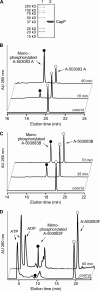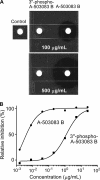Functional and kinetic analysis of the phosphotransferase CapP conferring selective self-resistance to capuramycin antibiotics
- PMID: 20202936
- PMCID: PMC2857116
- DOI: 10.1074/jbc.M110.104141
Functional and kinetic analysis of the phosphotransferase CapP conferring selective self-resistance to capuramycin antibiotics
Abstract
Capuramycin-related compounds, including A-500359s and A-503083s, are nucleoside antibiotics that inhibit the enzyme bacterial translocase I involved in peptidoglycan cell wall biosynthesis. Within the biosynthetic gene cluster for the A-500359s exists a gene encoding a putative aminoglycoside 3-phosphotransferase that was previously demonstrated to be highly expressed during the production of A-500359s and confers selective resistance to capuramycins when expressed in heterologous hosts. A similar gene (capP) was identified within the biosynthetic gene cluster for the A-503083s, and CapP is now shown to similarly confer selective resistance to capuramycins. Recombinant CapP was produced and purified from Escherichia coli, and the function of CapP is established as an ATP-dependent capuramycin phosphotransferase that regio-specifically transfers the gamma-phosphate to the 3''-hydroxyl of the unsaturated hexuronic acid moiety of A-503083 B. Kinetic analysis with the three major A-503083 congeners suggests that CapP preferentially phosphorylates A-503083s containing an aminocaprolactam moiety attached to the hexuronic acid, and bi-substrate kinetic analysis was consistent with CapP employing a sequential kinetic mechanism similar to most known aminoglycoside 3-phosphotransferases. The purified CapP product lost its antibiotic activity against Mycobacterium smegmatis, and this loss in bioactivity is primarily due to a 272-fold increase in the IC(50) in the bacterial translocase I-catalyzed reaction. The results establish CapP-mediated phosphorylation as a mechanism of resistance to capuramycins and now set the stage to explore this strategy of resistance as a potential mechanism inherent to pathogens and provide the impetus for preparing second generation analogues as a preemptive strike to such resistance strategies.
Figures





Similar articles
-
The Biosynthesis of Capuramycin-type Antibiotics: IDENTIFICATION OF THE A-102395 BIOSYNTHETIC GENE CLUSTER, MECHANISM OF SELF-RESISTANCE, AND FORMATION OF URIDINE-5'-CARBOXAMIDE.J Biol Chem. 2015 May 29;290(22):13710-24. doi: 10.1074/jbc.M115.646414. Epub 2015 Apr 8. J Biol Chem. 2015. PMID: 25855790 Free PMC article.
-
Revisiting the nucleotide and aminoglycoside substrate specificity of the bifunctional aminoglycoside acetyltransferase(6')-Ie/aminoglycoside phosphotransferase(2'')-Ia enzyme.J Biol Chem. 2012 Dec 21;287(52):43262-9. doi: 10.1074/jbc.M112.416453. Epub 2012 Oct 31. J Biol Chem. 2012. PMID: 23115238 Free PMC article.
-
Structure-guided optimization of protein kinase inhibitors reverses aminoglycoside antibiotic resistance.Biochem J. 2013 Sep 1;454(2):191-200. doi: 10.1042/BJ20130317. Biochem J. 2013. PMID: 23758273 Free PMC article.
-
Phosphoryl transfer by aminoglycoside 3'-phosphotransferases and manifestation of antibiotic resistance.Bioorg Chem. 2005 Jun;33(3):149-58. doi: 10.1016/j.bioorg.2004.11.001. Epub 2004 Dec 15. Bioorg Chem. 2005. PMID: 15888308 Review.
-
Strategies to overcome the action of aminoglycoside-modifying enzymes for treating resistant bacterial infections.Future Med Chem. 2013 Jul;5(11):1285-309. doi: 10.4155/fmc.13.80. Future Med Chem. 2013. PMID: 23859208 Free PMC article. Review.
Cited by
-
Biosynthetic and Synthetic Strategies for Assembling Capuramycin-Type Antituberculosis Antibiotics.Molecules. 2019 Jan 25;24(3):433. doi: 10.3390/molecules24030433. Molecules. 2019. PMID: 30691073 Free PMC article. Review.
-
A biocatalytic approach to capuramycin analogues by exploiting a substrate permissive N-transacylase CapW.Org Biomol Chem. 2016 Apr 28;14(16):3956-62. doi: 10.1039/c6ob00381h. Epub 2016 Apr 6. Org Biomol Chem. 2016. PMID: 27050157 Free PMC article.
-
The Biosynthesis of Capuramycin-type Antibiotics: IDENTIFICATION OF THE A-102395 BIOSYNTHETIC GENE CLUSTER, MECHANISM OF SELF-RESISTANCE, AND FORMATION OF URIDINE-5'-CARBOXAMIDE.J Biol Chem. 2015 May 29;290(22):13710-24. doi: 10.1074/jbc.M115.646414. Epub 2015 Apr 8. J Biol Chem. 2015. PMID: 25855790 Free PMC article.
-
Discovery and characterization of the tubercidin biosynthetic pathway from Streptomyces tubercidicus NBRC 13090.Microb Cell Fact. 2018 Aug 28;17(1):131. doi: 10.1186/s12934-018-0978-8. Microb Cell Fact. 2018. PMID: 30153835 Free PMC article.
-
β-Hydroxylation of α-amino-β-hydroxylbutanoyl-glycyluridine catalyzed by a nonheme hydroxylase ensures the maturation of caprazamycin.Commun Chem. 2022 Jul 28;5(1):87. doi: 10.1038/s42004-022-00703-6. Commun Chem. 2022. PMID: 36697788 Free PMC article.
References
-
- World Health Organization/International Union Against Tuberculosis and Lung Disease (2007) Global Project on Anti-tuberculosis Drug Resistance Surveillance. Anti-tuberculosis Drug Resistance in the World. 4th Global Report (World Health Organization, Geneva, Switzerland: )
-
- Demain A. L. (2009) Med. Res. Rev. 29, 821–842 - PubMed
-
- Yamaguchi H., Sato S., Yoshida S., Takada K., Itoh M., Seto H., Otake N. (1986) J. Antibiot. 39, 1047–1053 - PubMed
Publication types
MeSH terms
Substances
LinkOut - more resources
Full Text Sources
Medical

